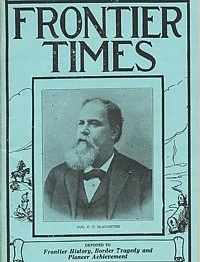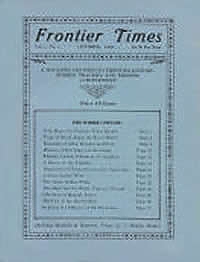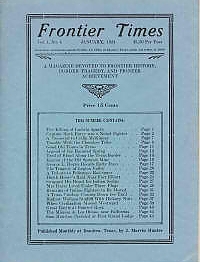By using our website, you agree to the use of cookies as described in our Cookie Policy
Magazines & Instant Downloads
Vol 08 No. 10 - July 1931
On the cover – C. C. Slaughter
Colonel C. C. Slaughter
C. (LUM) Slaughter was born in Sabine county, Texas, February 9, 1837. His ancestry dates prior to the Revolution in America. His father, George Webb Slaughter, was one of the most favorably known men in Texas. He came to Texas in 1830 with his parents when it was the Mexican State of Coahuila, and assisted in the nobel cause which won the freedom of the republic. For sixty-five years he was intimately connected with the growth of Texas. He was a farmer, cattle raiser and pioneer minister of the gospel, traveling hundreds of miles on horseback to meet his ministerial engagements.
The mother of C. C. Slaughter, before her marriage was Miss Sarah Mason, a woman of lofty character and a worthy helpmeet to her pioneer husband. Eleven children were born to Mr. and Mrs. Slaughter, of whom C. C. was the oldest. Here is an excellent account of this good man.
An excerpt: Eventually Mr. Slaughter arrived at the conclusion that cattle from the Brazos river were of a more desirable quality and size than cattle grown in East Texas. The stories of the drovers excited his curiosity, and he decided to visit West Texas and see for himself whether conditions were as favorable as described, and the summer of 1855 was spent by Mr. Slaughter and his father upon a trip into West Texas. The journey led them to the headwaters of the Colorado river and over hundreds of miles of territory where a cow had never set her foot-the undisputed home of the Indian and the buffalo. As the Indians and whites of Texas were then at peace, the journey was made without serious adventure, and a new home was selected far out on the frontier. Palo Pinto county was the ideal spot for a cowman; a broken country, watered by scores of clear, running streams, the valleys occupied by natural meadows whose grass was higher than a horse's back. The Slaughter ranch was located five miles north of the present town of Palo Pinto. In 1856 the young cowman drove the herd, now numbering 1,500 head, 300 miles to the Palo Pinto ranch, where he superintended the erection of a home for his father and mother. Fort Belknap was in convenient distance, and in a short time he was delivering beeves to the fort, and also carrying on a paying beef business with the Indian agents at the reservation of West Texas. All was moving smoothly and the fortune of the adventurous young cowman was rapidly accumulating, when suddenly an angry cloud appeared on the horizon.
Further Mentions: the hills of Sabine county * Prather's Prairie, on Trinity river, in Freestone county, Texas * Captain Sul P. Ross * Cynthia Ann Parker * Charles Goodnight, Colonel Kit Carter, George Lemley and Dick Jowell * In 1877 Colonel Slaughter established the Lazy S Ranch * At one time lie claimed a section of the Plains 200 miles square, or a total of 24,000,000 acres * Together with Kit Carter, J. C. Loving and John N. Simpson he established the Cattle Raisers' Association in 1873 *
Col. Wm. L. Black, A Progressive Pioneer
Account of Colonel William L. Black, a pioneer of Menard county, Texas, and pioneer in many fields of endeavor. For many years he resided in Dallas and became one of the largest property owners there.
An Excerpt: "Colonel Black did things. From the time he was born in New Orleans in 1843, he was busy. He must have been a wiggly sort of child, for when he was 18 he was wounded in the service of the Confederacy and when 20 he was sentenced to be hanged as a pirate. This sentence came as payment for his activities as a sailor in the Confederate navy. He and a group of friends and intimates, a total of 25, sought to capture a shipping vessel on the Pacific coast, destroy the whaling fleet of the Pacific and terrorize commerce and sent rich spoils to the Confederacy. Thus seven of them entered a boat at Panama one bright morning in November their baggage sent ahead containing guns which they never were able to get. The-next thing they knew they were marching down the streets of San Francisco, manacled, with cavalry for a guard and the musical comedy expedition had caught a note of tragedy. And it was their misfortune for this to happen when Lincoln was killed and the feeling was high. Lawyers thumbed big books, said big words, and pleaded their innocence yet the order was to hang. But young Black had the knack of knowing the right person and soon he was out and had the others out, too.
Account goes on to detail this particular event in his life, and also his work in the sheep business, the establishment of his ranch lands in Menard county, his efforts to overcome the prejudice against goat meat (he built a goat canning factory on his ranch); his campaigns for betterment of the ranchmen, his invention of the cotton picker, a new, non-friction rod for windmills, and the securing of a patent on a fire-proof house which was the fore-runner of the sprinkler system.
Further Mentions: his daughter, Mrs. Robert L. Winslow * the old Black ranch near McKavett * T. E. Hogg * Governor Machin of California * his friend Bogert * He helped form the New York Cotton Exchange * the U. S, Frigate Lancaster * Counsul McKee of Panama * Thomas J. Savage, acting United States Consul-General * Admiral Pearce * Captain Hogg * Captain Douglas * by S. R. Mallory, secretary of the Confederate Navy * E. A. Swaim, John Hiddle, T. J. Grady and. Joseph Higgins * Frank M. Pixley, lawyer * Major-General McDowell * Senator John Conness *
Henry Taylor, A Pioneer
By J. Marvin Hunter.
(Includes old photo of Taylor) Captain Henry Taylor, one of the grand old pioneers of the Sabinal Valley in Bandera county, Texas, was an early day ranchman, Confederate veteran, and minute man. He was born near Verona, Missouri, September 7, 1841, the son of Robert and Martha Taylor. He came to Texas with his father in 1861, and located near Weatherford, and a short time later enlisted in Burns Regiment, Company F, Crockett Howard captain, and became a sergeant in that company. He surrendered at Shreveport, Louisiana, where he received his discharge and returned home afoot. After remaining at home a while, he went to Montana and worked on the cattle ranges for a year or two, then went to California, when he found employment with an old friend of the family, Winfield Wright, who lived near Petaluma. Here he was joined by his brother, John Taylor, and they decided to return to Texas and buy a herd of cattle to drive to California, Winfield Wright advancing the money with which to buy the cattle. It was a long way to Texas, and they decided to go to San Francisco and take a boat, expecting to land on the Gulf coast of Texas, but after setting sail they found they would have to go via the Isthmus of Panama, and from there were carried to New York, then took to New Orleans, and from there to Galveston. They arrived in the Sabinal Valley sometime in 1869, where they purchased, from different parties 900 mixed cattle. This is his story and his recollection of stirring events that transpired when he first settled in the beautiful Sabinal valley, and of conditions that existed there in those trying times, when the Indians made frequent raids, killing settlers and driving off stock.
Further Mentions: his daughter, Mrs. J. H. Baumer * Devil's River in the vicinity of Howard's Well * Horsehead Crossing * Winfield Wright * Dick Stegler * A man named Joe Matthews * his brother, John Taylor * when he came into the Sabinal valley to make his home some of the settlers he found there were John Ware, Gidden Thompson, Ben Highsmith, Aaron Anglin, Chris Kelley, Bob Kincheloe and others. Shortly after reaching the Sabinal valley he and Joe Matthews engaged to run the Chris Kelley cattle near Sabinal on shares * married in 1873 to Miss Maggie Riley at D'Hanis, Texas * The children are Mrs. Sarah Baumer, Mrs. Mattie Fisher of Utopia ; Mrs. Madge Carter, Mrs. Janie Duke of Del Rio; Mrs. Carrie Cooper of Dallas; Mrs. Hattie Kelley of Del Rio; Mrs. Oho. Fuller, and Robert Taylor of Utopia *
Prairie Dogs And Rattlesnakes
A curious thing about the snake and the prairie dog is that each is mortally afraid of the other. The dog is afraid of being eaten by the snake, and the snake is afraid of being entombed by the dog. If the mother of the young dogs, on a return to the home hole, finds that a snake has intruded, she at once sets up a peculiar cry or bark, to which many citizens of the town instantly respond. They gather about the hole and in a moment all are at work filling it up. The quickness with which they can do this is remarkable. When the hole is filled they butt and pack the dirt in its mouth until it is almost as hard as the ground around it. There is then no chance for an escape of the snake. This account goes on to describe the effect that both of these animals has had in the lives of the early pioneers on the Texas frontier.
The writer had somewhat of an exciting experience with a rattler would be bed-fellow out in the Devil's River country of West Texas in, 1898. One night in camp alone a rattlesnake crawled up on top of the bed and Parker himself right there. The bed, I should explain, was made by spreading a heavy tarpaulin on the ground, and on this a quilt was laid, then a blanket for cover. The end of the tarpaulin, which was a heavy water-proof ducking was then drawn up to cover the whole bed, and when properly arranged was not only a comfortable bed, but if a heavy rain should fall that tarpaulin would shed the water as well as any good tent." I had gone to bed very tired after a hard day's work, and was just about to drop off to sleep when I felt a movement at the foot of my bed. Soon: I knew something was nosing around to get under the cover, and in a little while I felt a weight upon my feet. I came to the conclusion that it was a skunk, one of those odoriferous little animals which is so much dreaded by cowboys throughout the country, not only for its offensive odor, but because its bite is sometimes the cause of hydrophobia. I carefully planned what to do, as I lay there quietly waiting to see...
Further Mentions: Dr. C. Hart Merriam * Prof. W. W. Cooke *
The Adventures Of Big-Foot Wallace
John C. Duval. (Final installment - Continued from last month)
"Bigfoot" Wallace is one of the front ranking characters of Texas pioneer history. He is legendary as a soldier, settler, frontiersman and general all-around Texas character. A descendant of the great Wallace and Bruce clans of the Scotland, he carried on their zeal and nobility as a freedom-lover and a freedom-fighter. This excellent history of Wallace by John C. Duval was first published in 1870, and is therefore very close to the events that occurred in conjunction with the great man’s life. You will love reading these pages, and if you need the other 14 installments of this story, just let me know.
This installment further mentions: Captain Bragg * Jack Dobell * Jim Jackson * Doe Run * York's Creek * old Haco * Polly Jenkins
The Fence-Cutters War In Texas
C. E. Lee. There was a time in Texas when to be caught with a pair of pliers would have subjected the person so caught to suspicion and possibly arrest. The transition from the open range to the closed pastures, in West Texas, is a notable event in the history of the State. One of the episodes concurrent with and marking this change was the Fence-Cutters' War. Early in the 80's barbed wire fences began to appear in Texas. This new method of fencing marked an economic revolution. It made practical the fencing in of vast areas of land that had heretofore lain open because materials for fencing were not available on treeless prairies. All of West Texas, from Fort Worth to El Paso and from the Panhandle to the Rio Grande, was a vast open country, on which grazed millions of cattle. It is an oft-repeated tale that cattle, north of the Texas & Pacific Railway, drifted south before the "northers" every winter, had to .be rounded up next spring down in, South Texas, where their drift had been checked by the Rio Grande, and turned back north. Rounding up these tangled herds and cutting out the numerous brands, presented a difficult problem. The wire fence at once became popular as a means of holding these drifting herds. However, the land fenced in with barb-wire was not always the property of the owner of the cattle, nor the land under lease, for a lease law as yet had not been enacted. Coincident with the construction of the earliest barb-wire fences came the surge of settlers into West Texas. These pioneers won for themselves, the name of "nesters." Singly and in colonies, with or without legal title to the land, they each took up a section or more and asserted their right to hold it against all claims of cattlemen. This migration westward brought them in contact with wire fences. And here is where the trouble started, and this is the story.
HENDERSON AN OLD TOWN
Henderson, one of the important oil cities of East Texas, was deeded to the commissioners for the location of a city during the year 1843, by Gen. James Smith. This was soon after the organization of Rusk county, named in honor of the first United States Senator from Texas. The town was named for Hon. J. Pinckney Henderson, first Governor of Texas, there being a provision in the deed saying the town must be so named, and that if the name of the town should ever be changed from Henderson the property on which the city stood should revert back to the. heirs and assignees of the donor.
THE OLDEST TEXAN
Mentions: Isaac Brock * Mr. Brock lived for many years in McLennan county, near Valley Mills * was born in Buncombe county, North Carolina, March 1, 1778 *
NEWSPAPER FILES IN OHIO STATE LIBRARY IS A RICH FIELD FOR THE HISTORIAN
ELEPHANT SKELETON FOUND NEAR DALLAS
When Cherokee War Whoops Rang Through Texas
Hattie Seale Joplin. Story of the Isaac Killough family and the Killough massacre, which happened October 5, 1838. This was one of East Texas’ worst Indian tragedies. About five miles west of the present site of Mount Selman in the Cherokee hills, the Killough Cemetery is one of Texas' historic spots. For partially out of the Killough massacre came a new Indian policy which sealed the fate of the Texas Cherokees. The Killoughs along with other emigreant families, notably the Woodses and Williamses, from Talledega county, Alabama, pitched camp in this region on Christmas Eve, 1837. The long drive was over. There was plenty of room to romp and play. The grown-ups, too, rejoiced of er what they had found at the end of the journey-rich red soil, timber, game, fish, wild fruit, salt springs and iron ore. Well satisfied, they soon set to work hewing logs for houses, clearing land and planting crops. What did it matter that the nearest white neighbors were at Fort Lacey, 40 miles away! What if conveniences were lacking! It took more than isolation and hardships to rob this group of happiness. This is the sad account.
Further Mentions: Winsome Elizabeth Killough * Kias Williams, brother-in-law to her sister, Polly * Dog Shoot, leader of a band of warriors bent on revenge * Nacogdoches * Owen and Polly Williams * his brother, Elbert * the J. D. Williams family in Jacksonville * Chief Sam Benge * Gen. Thomas J. Rusk * Mrs. C. W. Matthews of Garden Valley, Smith county * Mrs. W. F. Partlow of Mount Selman
Fort Selden, New Mexico
Col. M. L. Crimmins. Fort Selden was established by General Pope in May 1865, at latitude 32 degrees 27 minutes 6 seconds, longitude 106 degrees 53 minutes 30 seconds in southern New Mexico, one and a half miles east of the Rio Grande. It was established at the southern end of the Jornada del Muerto, or "Journey of Death," as the long eighty miles stretch without wood or water was called. The Mescallero and Mimbres Apaches raided caravans passing through the Jornada, when they were exhausted by thirst and easily killed, and the post was established at this point to guard the Santa Fe Trail, and the Butterfield Trail crossing the Rio Grande at Leesburg. The nearest settiement was Dona Ana, nine miles south, Fort Bliss near El Paso, Texas, sixty-seven miles south; nearest telegraph station was at Santa Fe, two hundred and sixty-three miles north; the nearest supply station was at Fort union, New Mexico, three hundred and fifty miles north, and the nearest railway station was Kit Carson, Colorado, on the Kansas Pacific Railroad, six hundred and thirty miles north. This is the story of that Fort that was constructed as a key part of that chain of forts across the western frontier of the 1860’s, to control the Apache Indians while so many of the men were off to fight the battles of the Civil War. Fort Selden was one of the few posts in the United States that seemed to have been carefully and strategically selected. It was on high ground, partly enclosed by the Rio Grande in the form of an irregular crescent. Twenty-five miles to the east were the Organ Mountains and the Picacho Mountains four miles west
Further Mentions: Fort Stanton * Fort Cummings * Fort Bayard * Fort Union, New Mexico * Canada Alamosa, 55 miles northwest * Fort McRae * Fort Cummings * Fort Bliss * Lydia Spencer Lane, the wife of Colonel Lane who was placed in command of that post in 1869 * Captain J. G. Tilford, 3rd Cavalry * Atchison, Topeka and Santa Fe and the Southern Pacific Railway to El Paso * Lieutenant Guilfoyle, 9th Cavalry * the reservation near Ruidoso, New Mexico * the Apache chieftain, Nana * Rito Quenado * Lieutenant C. W. Taylor of the 9th Cavalry * Lieutenant Valois with Troop' I, 9th Cavalry * George `V. Smith * Garilan Canyon * Colonel Edward Hatch, 9th Cavalry * Hillsboro in Sierra county, New Mexico * the Mimbres River * Captain Charles Parker * Lieutenants Levi F. Burnett, and George H. Wright, 7th Infantry *
FORT'S CRUMBLING RUINS TO BE SOLD AT AUCTION
Brief account of Fort Sumner, New Mexico
$4.95
‹ Back








